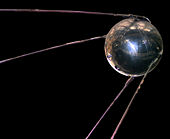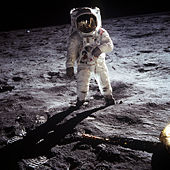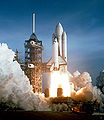Space exploration

|

|
| (From TOP to BOTTOM) - First man-made satellite in space Sputnik 1; - Astronaut Edwin Aldrin on the surface of the Moon. The Moon is currently the only natural extraterrestrial object that humans have walked upon. |
Space exploration is the physical exploration of outer space, both by human spaceflights and by robotic spacecraft. While the observation of objects in space — known as astronomy — pre-dates reliable recorded history, it was the development of large liquid-fueled rocket engines during the early 20th century that allowed space exploration to become a practical possibility. Common rationales for exploring space include advancing scientific research, uniting different nations and ensuring the future survival of humanity.
Space exploration has often been used as a proxy competition for geopolitical rivalries such as the Cold War. The early era of space exploration was driven by a space race between the Soviet Union and the United States; the launch of the first man-made object to orbit the Earth, the USSR's Sputnik 1, on October 4, 1957, and the first Moon landing by the American Apollo 11 craft on July 20, 1969 are often taken as the boundaries for this initial period. The Soviet Union achieved many of the first milestones, including putting the first man in space, Yuri Gagarin aboard Vostok 1 in 1961, and completing the first spacewalk (by Aleksei Leonov in 1965). In 1971, the Soviets launched the first space station, Salyut 1.
After the first 20 years of exploration, focus shifted from one-off flights to renewable hardware, such as the Space Shuttle program, and from competition to cooperation as with the International Space Station. From the 1990s onwards, private interests began promoting space tourism. Larger government programs have advocated manned missions to the Moon and possibly Mars sometime after 2010.
Various criticisms of Space Exploration are sometimes made, on cost or safety grounds, but public of many countries are nevertheless usually supportive of programs.
History
First orbital flights
The first successful orbital launch was of the Soviet unmanned Sputnik I (Satellite I) mission on October 4, 1957. The satellite weighed about 83 kg (184 pounds), and is believed to have orbited Earth at a height of about 250 km (150 miles). It had two radio transmitters (20 and 40 MHz), which emitted "beeps" that could be heard by any radio around the globe. Analysis of the radio signals was used to gather information about the electron density of the ionosphere, while temperature and pressure data was encoded in the duration of radio beeps. The results indicated that the satellite was not punctured by a meteoroid. Sputnik 1 was launched by an R-7 rocket. It incinerated upon re-entry on January 3, 1958.
This success led to an escalation of the American space program, which unsuccessfully attempted to launch Vanguard 1 into orbit two months later. On January 31, 1958, the US successfully orbited Explorer I on a Juno rocket. In the meantime, the Soviet dog Laika became the first animal in orbit on November 3, 1957
First human in space
The first human spaceflight was Vostok 1 (Sunrise 1) , carrying 27 year old cosmonaut Yuri Gagarin on April 12, 1961. The spacecraft completed one orbit around the globe, lasting about 1 hour and 48 minutes. Gagarin's flight resonated around the world; it was a demonstration of the superior Soviet space program and it opened an entirely new era in space exploration - manned space flights. The U.S. launched its first man into space within a month of Gagarin's flight with the first Mercury flight, by Alan Shepard. However, orbital flight was not achieved by the United States until John Glenn's flight nearly a year later. China launched its first taikonaut into space 42 years later, with the flight of Colonel Yang Liwei aboard the Shenzhou 5 (Spaceboat 5) spacecraft.
Key people in early space exploration
The dream of stepping into the outer reaches of the Earth's atmosphere was driven by rocket technology. The German V2 was the first rocket to travel into space, overcoming the problems of thrust and material failure. During the final days of World War II this technology was obtained by both the Americans and Soviets as were its designers. The initial driving force for further development of the technology was a weapons race for inter-continental ballistic missiles (ICBMs) to be used as long-range carriers for fast nuclear weapon delivery, but in 1961 when USSR launched the first man into space, the US declared itself to be in a "Space Race" with Russia.
- Konstantin Tsiolkovsky, Robert Goddard, Hermann Oberth and Reinhold Tilling laid the groundwork of rocketry in the early years of the 20th century.
- Wernher von Braun was the lead rocket engineer for Nazi Germany's World War II V-2 rocket project. In the last days of the war he led a caravan of workers in the German rocket program to the American lines, where they surrendered and were brought to the USA to work on U.S. rocket development. He acquired American citizenship and led the team that developed and launched Explorer I, the first American satellite. Von Braun later led the team at NASA's Marshall Space Flight Center which developed the Saturn V moon rocket.
- Initially the race for space was often led by Sergei Korolev, whose legacy includes both the R7 and Soyuz - which remain in service to this day. Korolev was the mastermind behind the first satellite, first man (and first woman) in orbit and first spacewalk. Until his death his identity was a closely guarded state secret; not even his mother knew that he was responsible for creating the Russian space program.
Other key people included:
- Valentin Glushko held role of Chief Engine Designer for USSR. Glushko designed many of the engines used on the early Soviet rockets, but was constantly at odds with Korolev.
- Vasily Mishin, Chief Designer working under Sergei Korolev and one of first Soviets to inspect the captured German V2 design. Following the death of Sergei Korolev, Mishin was held responsible for the Soviet failure to be first country to place a man on the moon.
- Bob Gilruth, was the NASA head of the Space Task Force and director of 25 manned space flights. Gilruth was the person who suggested to John F. Kennedy that the Americans take the bold step of reaching the Moon in an attempt to reclaim space superiority from the Soviets.
- Christopher C. Kraft, Jr., was NASA's first flight director and oversaw development of Mission Control and associated technologies and procedures.
Criticisms
Many criticisms of space exploration are particularly critical of exploration carried out by means of human spaceflight. It is more expensive to perform certain tasks in space with humans rather than by robots or machines. Humans need large spacecraft that contain provisions such as a hermetic and temperature controlled cabin, production of breathable air, food and drink storage, waste disposal, voice- and other communication systems, and safety features such as crew escape systems, medical facilities, etc. There is also the question of the security of the spacecraft as whole; losing a robot is nowhere near as dramatic as human loss, so overall safety of non-human missions isn't as much of an issue. All of these extra expenses have to be weighed against the value of having humans aboard. Some critics argue that those few instances where human intervention is essential do not justify the enormous extra costs of having humans aboard. However, others argue, with some reason, that many tasks can be more effectively accomplished by human beings.
Other critics, such as the late physicist and Nobel prize winner Richard Feynman, have contended that space travel has never achieved any major scientific breakthroughs. However, others have counter-argued that, besides the large (and otherwise unavailable) amount of planetary data returned by spacecraft, there have been many indirect scientific achievements: development of the modern computer, lasers, etc.
Some critics contend [citation needed] that in light of the huge distances in space, human space travel will never be able to do more than achieve an earth orbit or at best visit our closest neighbours in the solar system—barring any advances in the at present purely theoretical idea of faster-than-light travel—and even this will consume large amounts of money and will require complex spacecraft that will accommodate only a handful of people. Supporters of human space travel state that this is irrelevant, because its real value lies in providing a focal point for national prestige and patriotism. They suggest that this was the reason why the Clinton administration cooperated closely with Russia on the International Space Station: it gave Russia something to take pride in, and as such became a stabilizing factor in post-communist Russia. From this point of view, the ISS was a justifiable cash outlay.
Some people also have moral objections to the huge costs of space travel, and say that even a fraction of the space travel budget would make a huge difference in fighting disease and hunger in the world. However, compared to much more costly endeavors, like military actions, space exploration itself receives a very small percentage of total government spending (nearly always under 0.5%), and it is also frequently pointed out by pro-space advocates that the long term benefits could outweigh the short-term costs. In addition, the successful launches of Space Ship One, a privately constructed, reusable space plane developed for only $25 million dollars, has further diminished the impact of cost-based criticisms.
Overall, the public remains largely supportive of both manned and unmanned space exploration. According to an Associated Press Poll conducted in July 2003, 71% of US citizens agreed with the statement that the space program is "a good investment," compared to 21% who did not (Pollingreport.com).
This is not to say that space exploration advocates do not criticize existing programs. Some supporters of space explorations, such as Robert Zubrin, have criticized on-orbit assembly of spacecraft as unnecessary and expensive, and argue for a direct approach for human exploration, such as Mars Direct.
Twenty-first-century space advocates continue to work towards more advanced spacecraft, rotating space stations, lunar bases, and colonies on Mars. Some of these visions may come true, but significant obstacles remain.
Space colonization
Space colonization, also called space settlement and space humanization, would be the permanent autonomous (self-sufficient) human habitation of locations outside Earth, especially of natural satellites or planets such as the Moon or Mars, using significant amounts of In-Situ Resource Utilization.
Plans for the future colonization of space
Many past and current concepts for the continued exploration and colonization of space focus on a return to the moon as a "stepping stone" to the other planets, especially Mars. Traditional concepts also called for the construction of orbital shipyards for the construction of inter-planetary vessels. Unfortunately, such concepts were prohibitively expensive, with estimated costs of 450 billion dollars or more[citation needed]. During the 90's, however, aerospace engineer Robert Zubrin developed the "Mars Direct" plan, emphasizing the utilization of Martian resources. In his widely acclaimed book also entitled Mars Direct, Zubrin explained how human beings could be sent to Mars within 10 years, using existing or foreseeable technologies, at a cost of between 20-30 billion dollars. Other efforts included the Ansari X Prize, which offered a 10 million dollar prize to any private, non-government organization which could develop a spacecraft capable of launching three human beings into space, returning them safely to earth, and repeating the feat within 2 weeks. The X-prize achieved a resounding success with the launch of Space Ship One, which was developed from scratch for only 25 million dollars, a tiny fraction of the cost of a single space shuttle launch. This development was accompanied by other prize incentives,and plans for routine space tourist flights beginning in 2007.
Space agencies
While only the United States, Soviet Union/Russian and Chinese space programs have launched humans into orbit, a number of other countries have space agencies which design and launch satellites, conduct space research and coordinate national astronaut programs.
Gallery
Here are pictures of some space exploration firsts
- Laika.jpg
Laika, in 1957, became the first living being to be launched into space.
- Tereshkova.jpg
Valentina Tereshkova: First woman in space
- Apollo 11 first step.jpg
Neil Armstrong about to take the first step on the moon; the first human step on an extraterrestrial object
See also
- Main list: List of basic space exploration topics
- Robotic space exploration programs
- Pioneer program
- Luna program
- Zond program
- Venera program
- Mars probe program
- Ranger program
- Mariner program
- Surveyor program
- Viking program
- Voyager program
- Vega program
- Phobos program
- Discovery program
- Chang'e program
- Animals in space
- Animals in space
- Monkeys in space
- Russian space dogs
- Humans in space
Main articles: Astronauts and human spaceflight
- List of human spaceflights
- List of human spaceflights by program
- Vostok program
- Mercury program
- Voskhod program
- Gemini program
- Soyuz program
- Apollo program
- Salyut program
- Skylab
- Space Shuttle program
- Mir
- International Space Station
- Shenzhou spacecraft
- Vision for Space Exploration
- Aurora Programme
- Tier One
- Human adaptation to space
- Space colonization.
- Recent and future developments
- Crew Exploration Vehicle
- Exploration of Mars
- Future energy development
- Space tourism
- Private spaceflight
- Space colonization
- Interstellar spaceflight
- Timelines
- Timeline of space exploration
- List of human spaceflights
- Timeline of solar system exploration
- Timeline of the Space Race
- Timeline of artificial satellites and space probes
- Spaceflight records
- Other
- Spaceflight
- Atmospheric reentry
- Space station
- Space and survival
- Space disasters
- List of artificial objects on extra-terrestrial surfaces
- List of spaceflights
External links
National agencies
- http://www.nasa.gov National Aeronautics and Space Administration
- http://www.esa.int - European Space Agency
- http://www.space.gc.ca - Canadian Space Agency
- http://202.106.142.5/main_e.asp China National Space Administration website
- http://www.federalspace.ru/ Russian Space Agency
- Iran Space Agency website
- Indian Space research Organization
Other
- NASA Public Service Announcement for Space Exploration
- MarsDrive Consortium
- http://www.marsdaily.com
- http://space.skyrocket.de/
- http://www.planet4589.org/space/
- http://www.spacefacts.de
- http://www.vastbeyond.com
- http://www.space.com
- http://www.spaceflightnow.com
- http://www.spacedaily.com
- http://www.spaceref.com
- http://www.spacetoday.net
- http://www.nasaspaceflight.com
- http://www.nasawatch.com
- http://spaceflight.nasa.gov
- http://www.spaceinfo.org
- http://www.spacelist.org
- Universe Today - space news from around the Internet
- National Space Society - non-profit organization that promotes a spacefaring civilization
- http://www.russianspaceweb.com/
- Benefits of Space Exploration - bibliography from NASA.gov
- Technology Spinoffs from Space Exploration - NASA.gov
- 20 minute video essay on space exploration
- Encyclopedia Astronautica
- Explore Universe Website - space news and information
- Space Exploration - Photographs taken in Space
| |||||||||||||||
Credits
New World Encyclopedia writers and editors rewrote and completed the Wikipedia article in accordance with New World Encyclopedia standards. This article abides by terms of the Creative Commons CC-by-sa 3.0 License (CC-by-sa), which may be used and disseminated with proper attribution. Credit is due under the terms of this license that can reference both the New World Encyclopedia contributors and the selfless volunteer contributors of the Wikimedia Foundation. To cite this article click here for a list of acceptable citing formats.The history of earlier contributions by wikipedians is accessible to researchers here:
The history of this article since it was imported to New World Encyclopedia:
Note: Some restrictions may apply to use of individual images which are separately licensed.



